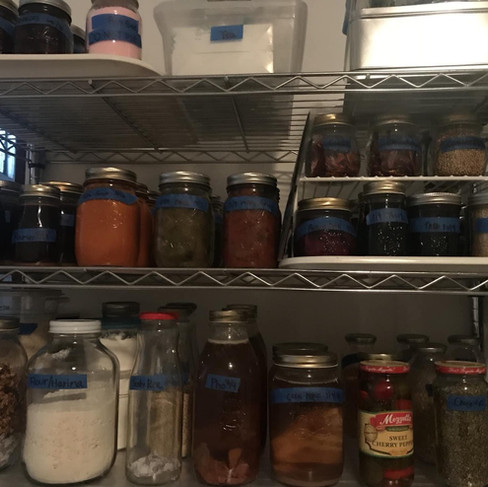How to Preserve Summer Veggies from Your Garden
- Yukari Bianchi
- Oct 30, 2024
- 6 min read
Updated: Feb 7

Although October in Colorado still has warm days, the leaves are changing, and winter’s coming. Our Bernese Mountain Dog, Senna, loves this cooler weather, and our cat, Ka-En, is cozying up in bed. With snow just around the corner, it’s the perfect time to preserve those summer flavors. Here’s a guide to storing beautiful, homegrown veggies through winter!
Water-Bath-Canning with Cucumber Pickles

Preserving, one of the most popular ways in the USA, is probably canning, which is how I got into preserving when we started the garden in our backyard. I started "Water-Bath-Canning" (or boiled water canning) by making pickled cucumbers. Many of our friends asked me if I'd make pickled cucumber every summer, and I was happy to make a big batch of them. It’s fun to pickle, not just cucumbers — think crisp pickled carrots and Jalapeño peppers. Chef Aric would peel the tomato skins before he canned them to make tomato sauce and salsa, locking in that vine-opened taste for winter. If you haven’t tried, here is a great site to learn more about!
Fermenting with Nuka-Zuke

My grandma’s pickling technique is called “Nuka-zuke” -Japanese rice bran pickles-. She would ferment cucumbers, tiny Japanese eggplant, and Napa cabbage in rice bran. It’s a traditional Japanese pickling method using a fermented rice bran bed called “Nuka-Doko.” (“Nuka” means “rice barn,” and“Doko” means “bed.”) My grandma would prepare the rice bran bed with salt, water, and Kombu (kelp), burying veggies to ferment. After a few days, she would take out the veggies from “Nuka-Doko,” slice them finely, and serve them on the table. The crisp bite and tangy, earthy flavor of cucumber and carrots, a little salty and tangy eggplant… as a kid, what my grandma did to those veggies was magic!
Nuka-zuke Steps:
Prepare rice bran bed with salt, water, and starter vegetables.
Bury fresh veggies in the bed for a few days.
Fermenting with Kimchi

Just like my grandma, I want to be good at fermenting one of my favorite side dishes in Korea. -Kimchi-. It’s been trials and failures, but I still enjoy making Kimchi. Like “Nuka-zuke,” making Kimchi is an art to me. Traditionally, people in Korea would coat Napa cabbage with porridge, veggies, and chili paste, folding the whole cabbage head together. (I put the paste in the chopped Napa cabbage to shortcut the process.) As the cabbage ferments, the flavors meld over time, bringing us the vibrant color of reds and greens with a bold and spicy kick in the flavor.
Kimchi Steps:
Make chili paste with carrot, green onion, and chili.
Apply chili paste to Napa cabbage leaves.
Fold cabbage heads and let ferment until desired spice and flavor.
Pressure Canning, Dehydration, Curing, and Brining

Living in humid Puerto Vallarta taught us to preserve out of necessity. Our house had a tiny refrigerator, and we only knew how to grocery shop like many Americans when we moved to Mexico. A big grocery shopping once weekly or every 10 days, stuff and stack up everything we need for the coming week. Soon, we realized we’d been wasting our groceries by leaving them on the kitchen counter to mold after a few days or letting them go bad in the refrigerator because we packed too many things in the little fridge. Chef Aric wanted to find a solution to this issue we encountered. He bought a big pressure cooker and started canning sauces, ramen stocks, and more, freeing up our tiny fridge. In a few months, Chef Aric had to build extra shelvings to put more jars, but when a hurricane hit, we had shelves packed with canned chili, curry, and stocks—a lifesaver when stores shut down.
After settling in Puerto Vallarta, we learned the rules of selling food were much easier than here in the States. The seller's responsibility was to ensure the food was cared for properly, and the buyer's responsibility was to know where the source was coming from. People in Mexico would open their own house’s garage, expand the kitchen, and serve food on weekends or evenings to make extra money to support their families. Chef Aric got an idea from that observation, and he built a “walk-in” smoker and a “dehydration” system using the natural sun and his woodworking skills. Initially, he built it for fun to cook and enjoy ourselves, but it turned into our “business,” selling sun-dried tomatoes, smoked bacon, ham, and turkey at local farmer’s markets on weekends in summer where expats and tourists would shop. Smoking, paired with curing, keeps flavors deep and smoky. He’d cure meats like bacon for five days, then cold-smoke them for rich, savory flavors for eight hours.
You can also preserve fish like salmon and herring by brining and smoking. We were blown out when we saw a pickled herring in a fancy, famous NY restaurant called Aquavit, where one of our favorite and respected chefs, Marcus Samuelsson, was still there. Of course, we ordered it. It’s been many years since then, but we still talk about how delicious and elegant it was to this day.
You can dehydrate summer veggies like zucchini and make zucchini chips, green bean chips, and sun-dried tomatoes like Chef Aric without building or buying a dehydrator.
Dehydration Steps:
Preheat oven to 140°F.
Thinly slice veggies and spread them on baking sheets.
Dry in the oven for several hours, turning occasionally to create crisp and concentrated veggie chips.
Or, if you have a sunny spot in the house, a greenhouse, or a garden box window, you can sun-dry fruit and veggies, especially if you live in Colorado, where it’s a dry climate. We sun-dry fresh herbs, like basil, oregano, and rosemary, since we have a garden box window in the kitchen, and we use it to sun-dry veggies, fruit, and herbs all year.
Oil-Infused Vegetables
Oil infusion locks in flavor and is simple to do. Chef Aric prepares oil-infused vegetables by blanching or roasting them. The result? Fragrant, herb-infused flavors are perfect for topping bread or pasta. This technique will be great for garlic, cherry tomatoes, peppers, mushrooms, zucchini, and herbs like rosemary, thyme, tarragon, and sage.

Oil Infusion Steps:
Blanch or roast veggies.
Place in sterilized jars and fully submerge in olive oil.
Store in the fridge, using within 1-2 weeks.
Compound Butter with Summer Herbs Compound butter is one of my favorite ways to preserve herbs; it’s easy, delicious, and versatile. Mix your favorite summer herbs into a compound butter to preserve them—Try chives, parsley, or dill, which make a winter morning toast feel like July. Compound Butter Steps:
Soften unsalted butter.
Finely chop herbs, mix them into butter and shape them into a log.
Chill for easy slicing and future use.
Yep, that’s it!
Alcohol-infused preserves with Ume-Shu (Japanese Plum Wine)

Back in Japan, my grandma kept jars of ume-shu (plum wine) under the sink. This sweet, tangy liqueur steers young plums in alcohol, traditionally enjoyed over ice or with soda. If you like to eat sushi at restaurants, you may see “plum wine” on the menu, but It’s a long process, and my grandma made it from scratch! Ume-Shu Steps:
Place green, unripe plums in a jar with sugar.
Cover it with shochu or sake and steep it for several months.
Preservation and Climate Influence

Climates have much to do with preserving. Low temperatures suit drying and curing in colder climates like Northern Europe and Russia with sauerkraut and cured meats. At the same time, hotter regions (like Southeast Asia) rely on pickling to prevent spoilage. Local produce and ingredients also influence preservation; Mediterranean climates yield olive-based preservation (olive oil storage), while colder climates favor root vegetable storage.
Preservation and Traditions Japan and Korea have unique cultural backgrounds in preserving food. In Korea, kimchi-making, or "kimjang," is an annual family and community event that dates back centuries. Traditionally prepared in late autumn, kimjang involves families gathering to make large batches of kimchi. It represents unity and also is believed to strengthen immunity, making it a symbol of resilience and health. In Japan, nukazuke requires daily care and maintenance. This process is often passed down through families, and the nuka-doko can be kept and enriched over generations. Nukazuke represents patience, tradition, and a sustainable approach to food, as the bed is maintained and reused for continuous pickling.
What summer veggies are you saving this year? Tell us in the comments!
Are you curious about how Chef Aric preserves meat and veggies? Sign up for our email newsletter for tips and recipes!











































Comments